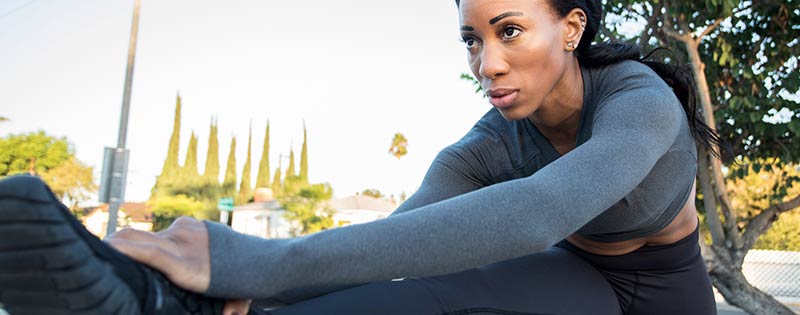by Brent Hearn •
“To stretch or not to stretch? That is the question.”
– Probably some guy lacing up his running shoes at a park somewhere
If you want a little free entertainment (or just like to stir things up), find a group of fitness enthusiasts and do a casual fly-by of their conversation. Make it a point to ask, “What are your thoughts on stretching?” Then grab some popcorn and watch the fireworks.
There’s no shortage of theories on the importance of stretching: how to stretch “correctly,” and how much you should stretch before a workout—or if you should at all. (Debate has raged for years about the efficacy of pre-workout stretching. One recent study published in The Journal of Environmental Research and Public Health found that both dynamic and static stretching—see below to learn the difference— performed pre-workout, improved running economy and lowered perceived rates of exertion.)
One thing that’s generally agreed upon is that having a body that moves well is good for you. And since having and maintaining a degree of flexibility is a key part of moving well, stretching should be an important part of any overall fitness plan.
How to Stretch
We won’t go into any specific stretches here. (There are countless stretching routines you can watch on YouTube and articles you can read for that.) Instead, we’ll focus on some general guidelines for you to consider once you’ve decided which program is right for you. As always, consult a physician before beginning any new fitness routine, particularly if you have injuries or other health concerns.
- It’s safer to stretch warm muscles than cold ones.
If you do decide to stretch before your workout, though, it’s important to get those muscles moving a bit first. Whether you’re about to start a vigorous hike, a court-pounding tennis session, or a long run, do something to get the blood flowing a bit before beginning your workout in earnest. - Save the bouncing for the trampoline park.
Ballistic stretching involves using bouncing movements to move beyond your body’s normal range of motion. While there’s debate (surprise) about whether some athletes should use ballistic stretching, it’s probably not worth the risk of injury for most of us. - Instead…
Try static stretching, which consists of holding a stretch for a specific amount of time, or dynamic stretching, which involves stretching muscles through their range of motion. (You’re generally not moving once you’re in a static stretch; you generally are when you’re doing a dynamic stretch.)
If you’re looking for other options, try yoga, Pilates, or tai chi. These activities feature slower, more controlled movements, and the class setting might motivate you to stick with your newfound commitment to flexibility. - Tension is fine. Pain is not.
If it hurts, back off; you’ve gone too far. Like most things that are worthwhile, increasing your flexibility takes time. Keep at it, and don’t try to do too much too fast.
Let the coaches, researchers, and elite athletes debate about how much stretching to do, how often, for how long, and whether pre-workout or post-workout stretching is better. Unless you’re planning to go toe-to-toe against an Olympic gymnast anytime soon, you don’t need a world-class stretching routine; you just need to have a sensible program that contributes to your general health and your particular fitness goals.
A body that moves well is a body that lives well. And that’s something that shouldn’t be much cause for debate.
Sources:
https://www.health.harvard.edu/staying-healthy/the-importance-of-stretching
https://www.runnersworld.com/uk/news/a37971176/stretch-before-run/
https://www.healthline.com/health/ballistic-stretching-it-safe#benefits









 ▶︎
▶︎  Why is the Discount Challenge prize amount $15,024? Because that is the average “per-occurrence” fine for Medicare inducements. That’s not $15,024 per patient, that’s not per provider, that’s PER VISIT. Stinks, doesn’t it? To us, the prize amount is worth the investment if we can help our profession better understand proper discounting.
Why is the Discount Challenge prize amount $15,024? Because that is the average “per-occurrence” fine for Medicare inducements. That’s not $15,024 per patient, that’s not per provider, that’s PER VISIT. Stinks, doesn’t it? To us, the prize amount is worth the investment if we can help our profession better understand proper discounting.